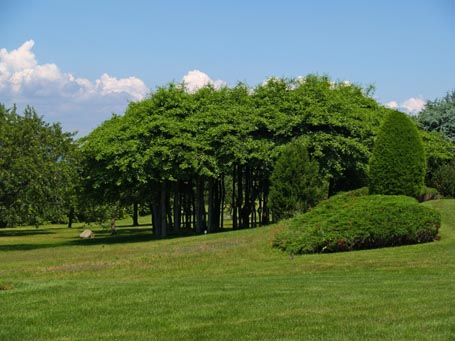 The New York Times discusses “green" building which really isn’t all that green. In the Sunday article Mireya Navarro writes that research by the U.S. Green Building Council, which administers the LEED (Leadership in Energy and Environmental Design) program, “suggests that a quarter of the new buildings that have been certified do not save as much energy as their designs predicted and that most do not track energy consumption once in use.” The article comments on a study the USGBC performed last year of certain buildings certified through 2006. Navarro continues, “Anecdotal information from follow-up research to that study indicated that the best-performing buildings had limited window areas and tended to be smaller.” Big surprise. Smaller buildings generally have fewer windows than larger buildings, and by the very nature of their smallness, smaller buildings are easier on the environment. It’s only common sense. I wrote about common sense green design here.
The New York Times discusses “green" building which really isn’t all that green. In the Sunday article Mireya Navarro writes that research by the U.S. Green Building Council, which administers the LEED (Leadership in Energy and Environmental Design) program, “suggests that a quarter of the new buildings that have been certified do not save as much energy as their designs predicted and that most do not track energy consumption once in use.” The article comments on a study the USGBC performed last year of certain buildings certified through 2006. Navarro continues, “Anecdotal information from follow-up research to that study indicated that the best-performing buildings had limited window areas and tended to be smaller.” Big surprise. Smaller buildings generally have fewer windows than larger buildings, and by the very nature of their smallness, smaller buildings are easier on the environment. It’s only common sense. I wrote about common sense green design here.
by Katie Hutchison for House Enthusiast
Web tour: Zippy The Pinhead discovers quoins
 When I was describing the location of my house to a friend, she said, “Oh, the one with the fake quoins?” Though, I did get her drift, I felt a correction was in order. “No, the one with the real quoins,” I responded.
When I was describing the location of my house to a friend, she said, “Oh, the one with the fake quoins?” Though, I did get her drift, I felt a correction was in order. “No, the one with the real quoins,” I responded.
Quoins are the large, alternating blocks that climb and wrap the corners of many antique buildings. On my c. 1768 Georgian home, they are wooden (not “fake”) and take their inspiration from the sizable, masonry blocks often set to form the corners of classical, stone or brick buildings. They lend the buildings they adorn a certain heft, an appearance of elegant authority. Many folks are quite taken with them. Earlier this week even Zippy The Pinhead fell under their spell.
by Katie Hutchison for House Enthusiast
Web tour: Boston Globe: Gardeners for hire
Wednesday's Globe highlighted a growing phenomenon which is win-win for everyone. Michael Prager's article features three "urban ag outfits" in the Boston area that participate in lawn farming. Their innovative business models range from full care, using homeowner property for community supported agriculture (in which property owners get a share or portion of a share depending on garden size); to garden creation, so homeowners can grow their own produce; to consulting.
Living in a condo, with only a tiny patio, a lawn farm isn't an option for me, but I'd happily contribute to a nearby urban community garden farmed by others. (As I've confessed before, I'm not much of a gardener, more of a garden fan.) Or maybe, just maybe, it's time for me to give this community gardening thing a try. Either way, Grow Salem will be hearing from me.
by Katie Hutchison for House Enthusiast
Web tour: Grey Gardens 2.0
I nearly missed last week’s New York Times article by Julie Scelfo about the transformation of the Grey Gardens property. Sally Quinn, the writer, and her husband Benjamin C. Bradlee, former executive editor of The Washington Post, acquired the derelict East Hampton, NY manse and overgrown grounds in 1979. Today, the surrounding lush gardens by Victoria Fensterer are breathtaking, as both the Times article and images will attest. Unfortunately, pictures of the resuscitated 10-bedroom dwelling (c. 1897) are not featured, but exquisite black and white before shots set the scene for what must have been a Herculean home-improvement project.
You may have noticed Grey Gardens much in the news lately, thanks to the recent airing of a new HBO Films production titled Grey Gardens based on the 1975 Maysles brothers’ documentary also titled Grey Gardens. There’s even a Grey Gardens book coming out in May, 2009, and there was a 2006-2007 acclaimed Broadway musical inspired by the same story. Both films, the musical, and the book feature Edith Bouvier Beale, known as Big Edie, and her daughter Little Edie who were, respectively, aunt and cousin to Jacqueline Bouvier Kennedy Onassis. Despite lives among New York’s high society in the late 30’s, by the 70's the Beales were isolated on their East Hampton estate, living in squalor among cats and raccoons. It’s this bizarre later phase that the Maylses captured with cinéma-vérité. In 1976 the Times published an interesting review of the uncomfortable documentary. The story of Grey Gardens has what Malcolm Gladwell might call the stickiness factor. It continues to capture our attention and imagination.
The re-imagined gardens further tap into the property's mystique. In the Times recent piece, Nora Ephron, a friend to Quinn and Bradlee, says of the grounds, “…I’ve never seen a picture of it that ever conveyed how amazing it is because, in some way, it’s a sort of a distant cousin to the wildness that was there when the Bradlees bought the house.” It sounds and looks like it’s full of enticing, exuberant vignettes. There’s even a little thatched-roof vintage cottage out back. How I’d love to see that featured in detail.
by Katie Hutchison for House Enthusiast
Web tour: Fix Housing First
Considering the dismal state of the housing market, it’s nice to see that there’s a coalition proposing a solution; it's the Fix Housing First Coalition. On the FHF website, Jerry Howard, President and CEO of the National Association of Home Builders, describes how we should and can fix housing first.
Howard notes that housing is the largest sector of the economy, and that with its collapse, it’s brought down two other sectors, the financial sector and the manufacturing sector. Howard argues that fixing housing first will help fix the other sectors. He sees a clear housing solution: “Stimulate the demand side; stabilize the supply side, and you have the sure fix.”
The Fix Housing First Coalition proposes non-refundable, short-term tax credits for all home buyers, plus below-market, 30-year fixed mortgages (available for a limited time), and continued foreclosure prevention. Visit the website to learn more.
FHF link by way of David Andreozzi via The Congress of Residential Architects
by Katie Hutchison for the House Enthusiast

